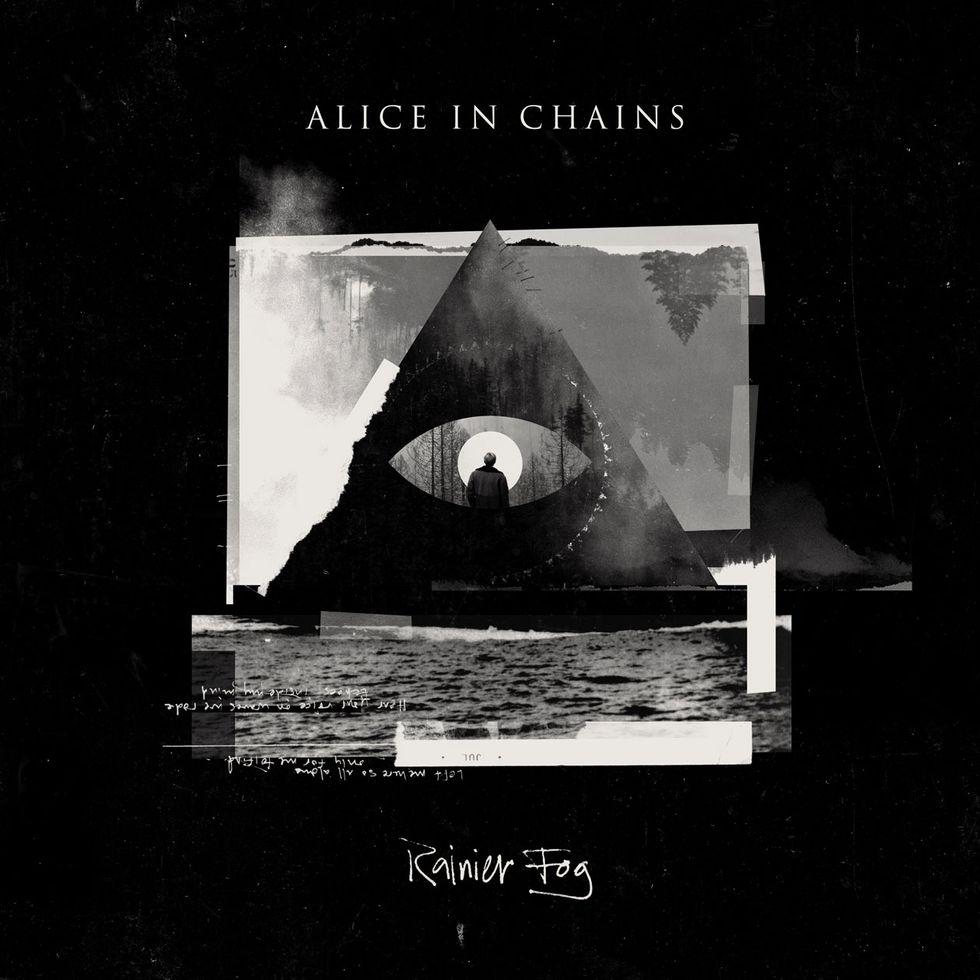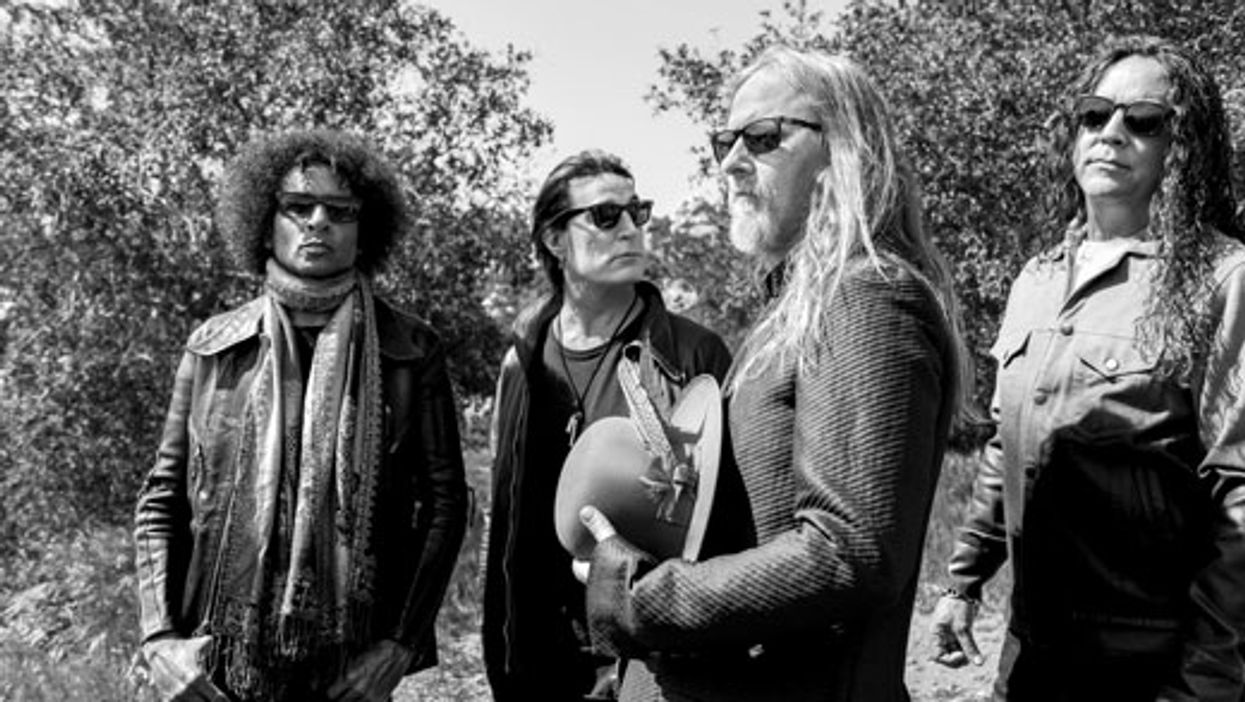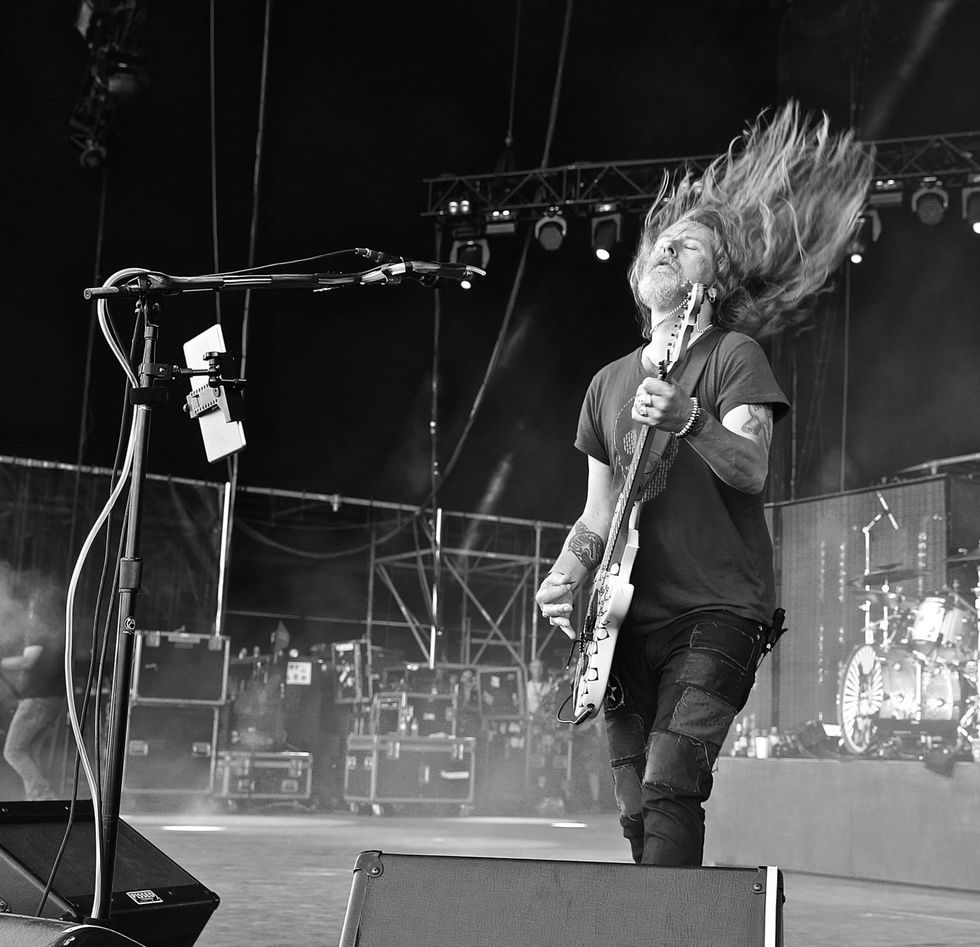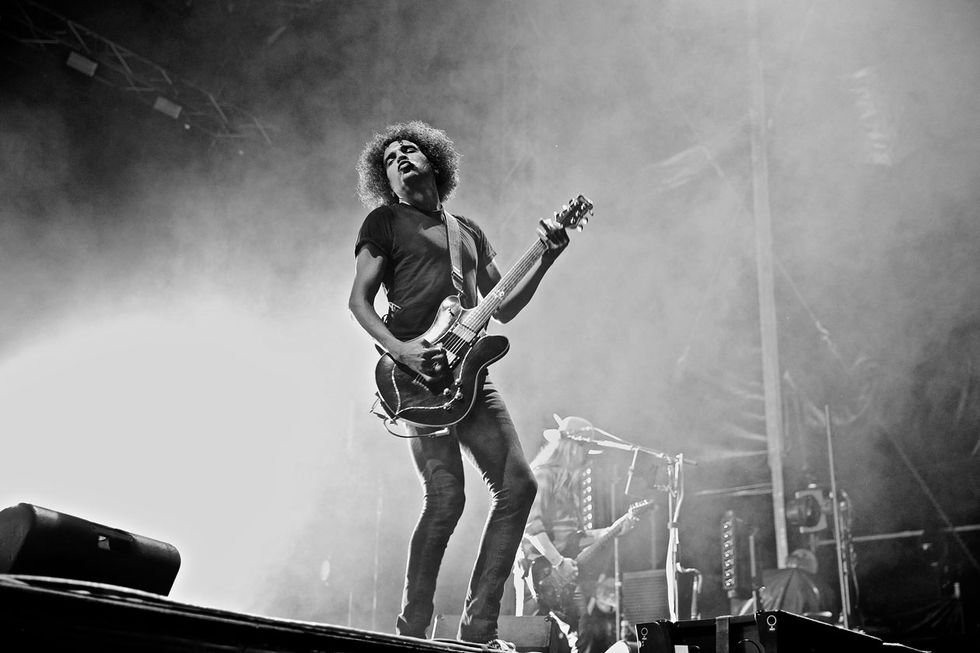It's been five long years without a release from Alice in Chains. And with harder music disappearing from the airwaves, rock 'n' roll was desperate for their return. Well, return they have. Rainier Fog, the band's latest offering of haunting harmonies, pummeling guitar work, and dark imagery, is sure to instantly grab the attention of all AIC fans. But the band's new-found ability to embrace their past with a triumphant look forward separates this album from anything in their lauded catalog.
As this incarnation of the band—guitarist/vocalist Jerry Cantrell, guitarist/vocalist William DuVall, bassist Mike Inez, and drummer Sean Kinney—drops their third full-length album, it's hard to believe they've been together longer than any of the band's previous lineups. And in fact, Cantrell and DuVall were actually sowing the seeds years prior.
As part of Cantrell's touring solo band in the early 2000s, DuVall had all the opportunity he needed to learn the ins and outs of Cantrell and the late Layne Staley's unique sound. “2001 and 2002 were heavy groundwork years," DuVall says. “Everything happening now is a result of that."
But it wasn't an easy road getting to now. Throughout the band's career, it has been infamously plagued by addiction, the passing of bandmates [original frontman Staley in 2002 and original bassist Mike Starr in 2011], and the loss of friends and notable musicians who shared the '90s spotlight on Seattle.
It's a history that weighed particularly heavy on Rainier Fog. “I was thinking about Chris Cornell who had just passed the month before," laments DuVall. “Of course, I was also thinking about Layne Staley. And of course, I was thinking about Cobain."
But times do change, and wounds do begin to heal. And for what may be the first time, the rays of hope and celebration are able to cut through the cement-thick grooves and minor-key dirges that fill Rainier Fog. It's hope and celebration that comes from confronting the band's ties to the Emerald City, the pain brought by years of loss, and most importantly, the victory and hallowed place in rock history that AIC and their fellow Seattle rockers share.
“There was a lot of looking toward home, and it wasn't in any sort of bummer or negative way," Cantrell explains. “It's just that we're a Seattle band. It's where we fucking started and it's still who we are. We're really proud to be part of the history of our town."
That pride in their hometown is why the band chose to track much of Rainier Fog at Studio X in Seattle, the same studio the band recorded their last full-length with their legendary original frontman. And the band was meticulous in taking their time to get it right. They even brought back Nick Raskulinecz, the man behind the desk for the band's successful Black Gives Way to Blue (2009) and The Devil Put Dinosaurs Here (2013). One listen through punishingly heavy tracks such as “Red Giant" and the album's second single, “So Far Under," as well as the band's trademark acoustic-driven tracks like “Maybe," and it's clear the effort has been fruitful.
Fresh off a European leg of a tour supporting the new album, Cantrell and DuVall took time to speak to Premier Guitar about what it means to be in Alice in Chains today. From waxing ecstatic about their own signature guitars and amplifiers to illustrating how the spirit of Seattle remains the fifth member of the band, it's clear both guitarists still carry a passion for their music while embracing their past and future more readily than ever.
Rainier Fog mates elements of classic Alice in Chains with new sonic twists. Were you focused on having such a broad reach?
Jerry Cantrell: There's not really a plan ahead of time on where we're going. It's just that we're starting a journey, and we don't know where it's going to end. Wherever it ends up, that's what the record's going to be. I think that's a hallmark of this band, that we don't know where the fuck we're going [laughs]. But we know we're going to get somewhere. And if we didn't get there, you wouldn't hear it [laughs].
Will, this is your third album with the band. What do you think you bring to the classic Alice in Chains sound?
William DuVall: It's just myself. Even if I write something I know those guys will respond to, like I wrote “So Far Under" on the new album and the lyrics to “Never Fade," and a song like “Last of My Kind" on the Black Gives Way to Blue album, or the riffs I wrote for “A Looking in View" and “Phantom Limb," those are all things that, even if it's being adapted to the certain sonic signature of this band, it's still me.

Alice in Chains recorded Rainier Fog in Seattle's Studio X, the same studio the band used to record its 1995 self-titled album. They enlisted Nick Raskulinecz, who produced the previous two AIC studio albums in 2013 and 2009.
Cantrell: He always comes up with some really important stuff for each record, just like all of us do, “So Far Under" in particular. From “It Ain't Like That" [Facelift] on, there's always a song or two that's based on a weird, bendy riff. On the last couple records, there was “Stone" and “Check My Brain." But on this one, I didn't write one of those. And the funny part is that the signature bendy Alice-type song, Will wrote this time. And that's cool because Layne did the same thing with “Hate to Feel" and “Angry Chair." So it's a tradition, and it means he's really in there.
Another one of those signature Alice in Chains elements is the way you work acoustic guitars into your songs and arrangements. What is it that appeals to you about the heavy and acoustic juxtaposition?
Cantrell: I've actually been talking a lot about this recently, about the importance of that Sap EP. The importance of putting that EP out immediately following a really successful record [Facelift] that put us on the map. And it was the only record we had, so that's what people identified us as. It was a gamble. But by doing that, it set a tradition for us and opened up the playing field of, “We can do whatever the fuck we want. We don't just have to be a fucking heavy band all the time." You could even make the argument that some of the heavier shit we've done is the acoustic-based stuff. “Nutshell" has just as much weight as “Them Bones."
“We're a Seattle band," says Jerry Cantrell. “It's where we fucking started and it's still who we are. We're really proud to be part of the history of our town." Photo by Scott Dachroeden
A great example of stretching out is “Never Fade." It introduces a very uplifting sound and feel to the band's palette.
DuVall: I think it's part and parcel of how long we've existed in this second incarnation of the band. There is a survivalist element that has always been in the band's music. And now, because we've gotten to this certain place, I think the survivalist and celebratory element is more able to come to the fore than ever before. It's a gradual thing that happens. But now that we're on our third album, perhaps people are noticing it more, or perhaps we're accenting it more.
Cantrell: That song is a bit different for us, for sure. But again, it's new territory to explore. It's actually a song that was not going to be on the record. I had this great chorus for it, but I just couldn't come up with something that I liked in the verses and the pre-chorus. So it just laid around for a while. And we were almost at the end of tracking when Will got a hold of it. He went into the back room and came up with a really cool verse and a pre-chorus. We ended up approaching it completely separately. And what he's writing about is totally different than what I was writing about. Not unlike what Layne and I did with “Rain When I Die."
You chose to record with Nick Raskulinecz again, which makes three albums in a row. What draws you back to him?
Cantrell: Nick's just an amazing producer, and he's a real fan of rock 'n' roll. He's like the same kid you smoke dirt weed joints with, in his bedroom in seventh grade listening to Rush records, trying to figure out how to learn to play them [laughs]. That's him, and he never lost that. And we have that element to us, too, so we get along great. And doing three records together, we can read each other before anything is even said. There's not a lot of B.S. There's a lot of laughing, a lot of good times, and we're all trying to make the best record we can make.
DuVall: Just a good energy. He comes in air drumming, headbanging to air guitar, and joking and laughing. It's nice to have that. And then, of course, he's just good, man. He's good at what he does.
Jerry, you're known for stacking a lot of amps to get your studio tones. What did you use to get your sound on this album?
Cantrell: I'm using a lot of my signature Friedman amps, the Double J [JJ], a good handful of Bogners, which I've always used as well, and some Marshalls. And I used an Orange and a Laney. If you're going to layer a lot of stuff, which I like to do, you've got to change it up. Otherwise, if you just keep putting on multiple tracks of the same guitar and the same amp, it ends up canceling itself out.

Guitars
G&L Rampage Jerry Cantrell Signature
Various Gibson Les Pauls
Various Gibson SGs
Various Fender Telecasters
Nash T-style silver sparkle
Gretsch G6131-MY Malcolm Young Signature Jet
Guild Studio ST-series electric
Guild dreadnought
Guild 12-string acoustic
Various Gibson acoustics
Amps
Friedman JJ Jerry Cantrell Signature Head
Friedman 4x12 with Celestion 25-watt Greenbacks and 30-watt G12Hs
Effects
Dunlop Jerry Cantrell Signature Cry Baby Wah
Electro-Harmonix Memory Man delay
Electro-Harmonix Electric Mistress flanger
Dunlop Rotovibe
MXR Talk Box
Boss DD-3 Digital Delay
Ibanez TS808HW Tube Screamer
Boss CE-5 Chorus Ensemble
Strings and Picks
Ernie Ball Slinky (.010–.046)
Dunlop Tortex 1.14 mm purple
An oddball thing that we used on this record, and there's usually one of these on each one of our records, Nick went down to the Pike Place Market and bought a cigar-box amp. It's just a cigar box with a fucking input, a volume knob, and a speaker. It cost probably 150 bucks. On that heavy part of “Drone," when those chords come in, you can really hear the barking sound of that cigar-box amp.
And there's always a flotilla of G&L Rampages around and four or five Les Pauls that I've had for years. And that's pretty much the base of the sound.
Tell me about your relationship with Dave Friedman and how your signature JJ amp heads came about.
Cantrell: Dave and I have been friends for a long time. As far as I'm concerned, he's a real guru of tone who knows what a rock guitar is supposed to sound like. So we started talking a few years ago about putting a signature amp together that's my amp and is tailored to me. It's a bit spendy for an amp, for sure. But it's exactly my amp. It's not a cheaper simulation of my amp that's made somewhere else with not-quite-the-same parts. It's exactly my amp.
You're also known for your wah work. Did you use your signature Dunlop Cry Baby on the album?
Cantrell: I think we exclusively used the Dunlop JC wah. Dunlop's always been a part of our sound. And kind of similar to the Friedman thing, I was talking to Scott Uchida, who used to be one of the main guys over there at Dunlop, and he said, “Let's make you a signature wah that's a little bit more tailored to your sound, a little darker, a little throatier." And they made a great piece of gear for me. I'm very honored to slap my name on that thing. I see them pop up a lot in someone's dressing room or when I'm watching someone play onstage. It makes me fucking proud. And it also makes me happy to be part of the story.
William DuVall helped design his signature Framus Talisman guitar, which features custom PAF-inspired pickups handmade by Dave Stephens of SD Pickups. Photo by Scott Dachroeden
Will, you recently released a couple of new signature pieces of gear with Framus and Metropoulos Amplification. Tell us about the guitar.
DuVall: Well, it's the result of working with Framus for about five or six years. Every year I'd go out to NAMM and Marcus Spangler and Hans-Peter Wilfer would say, “When are you going to come up with a guitar that you designed?" Every year it was a running topic. But one day, I was in a hotel somewhere, and I got out the stationary and started doodling around. I thought, “This is pretty cool. This is worth showing Marcus." So I sent it and we went back and forth a little bit dealing with technical and engineering things. And the end result is the Talisman. It's something that, from the first sketch to the guitar that I'm playing onstage now, I was involved in every step, and very proudly so. I went traditional in terms of my particular guitar that I'm playing. It's a mahogany body with a maple cap, like a Les Paul. I just wanted something that was slimmer, sleeker, and my own personal take on it.
And to take it even further, I got these Dave Stephens pickups. He's out of Washington state as well. That man has reverse-engineered the PAF in a way that I don't think anybody ever had. I sent him one of my Les Pauls, and when he sent the guitar back, it was night and day. The very next day I recorded the guitar solos to “So Far Under" on that Les Paul. So when we got the production model Talismans ready, the first two they sent me I sent straight to Dave. And honestly, I've ripped out all the rack stuff that I had in my setup. I was like, “This is so great that I'm not trying to complicate it in any way." So I have a few floor pedals, I've got my [Metropoulos] DVL-1 amp, the Talisman, and we're done.
Talk a bit about your signature DVL-1 amplifier.
DuVall: George Metropoulos and I have known each other for over 10 years, and I love the man. And on a technical level, he is obsessive. He is the foremost authority on Marshall plexi amps, particularly from the mid to late '60s. It was like, “You know, we should do something together." And because I was just working out the thing with the Talisman with Framus, it was perfect timing. I think the DVL-1 is the highest, in terms of signal purity to functionality, of any amp in that style. His plexi-style stuff is my baseline. But I need a clean thing that's a little more Vox-y, and I wanted more functionality. So we ended up going with a 2-channel, 4-mode design. I'm just over the moon.
How did recording at Seattle's Studio X—the same studio the band recorded its 1995 self-titled album in—impact the record's sound?
DuVall: I can definitely say there was some level of trepidation on the part of all of us. For them, it was sort of a confronting a part of their past that maybe wasn't the happiest period of the group. And for me, it was coming to grips with their past and confronting what my place in this history is.
I mean, the lyrics to “Never Fade" were written at Studio X. And there's a reason for that. It was a moment where I was letting all of that stuff channel through me, wash over me, and not being shy about it. I stayed in there pretty much all night, alone. And by the time I walked out, I had “Never Fade." When I walked out into the Seattle dawn, I felt like I'd had a spiritual experience and a little bit of a reckoning with all the things we're talking about. But it couldn't have been written like that in any other place. It had to be written there. So that's a direct result of working in Seattle at Studio X.

Guitars
Framus Talisman William DuVall Signature
Gibson Les Paul VOS '59 Sunburst reissue
Framus Diablo
Framus Panthera
Framus Idolmaker
Gibson Hummingbird
Amps
Metropoulos DVL-1 William DuVall Signature Head
Hermit Cab iso cab
Metropoulos 4x12 with Celestion Greenbacks and Celestion Golds
Effects
MXR Phase 95
MXR Carbon Copy Analog Delay
Boss CE-5 Chorus Ensemble
Strings and Picks
Ernie Ball Slinky .010–.046 strings
Dunlop Tortex 1.14 mm purple
From tracking there, to the title of the album, and even the subject matter, it seems Seattle is almost a character in the album.
Cantrell: It absolutely is. Some things just start popping up that start pointing in a single direction. For instance, I was doing some early demos at my house and having Duff [McKagan, Guns N' Roses, Seattle native] come over and put some bass lines down for some songs that I was trying to put together for the band. And then having Chris [DeGarmo, Queensrÿche] on the record, us deciding to track it in Seattle, and then writing a song like “Rainier Fog," things just started to line up. So when it came time to name it, it made sense.
Like you said, Chris DeGarmo's performance on the song “Drone" is another of the album's connections to Seattle. How did that come about?
Cantrell: It was really cool having Chris come down. He just showed up the day we were working on “Drone." I was tracking that middle part. I hadn't played it in a while and it's a weird spider chord where the base of it is your pinky on the low E with your fingers kind of bent back across the neck. On an acoustic guitar, you kind of need to warm up a bit to do it [laughs]. So I was chowdering it, and was like, “Dude, you want to try this?" And he said, “Fuck yeah! I'll fucking try it." So he sat down and I showed him the part. He had it tracked within an hour or two.
Very few Seattle bands throughout the decades sound anything alike. Yet there's a noticeable thread that connects them all. What do you think that is, and why do you think Alice in Chains plays such a pivotal part in that?
Cantrell: I think the big picture is that there are so many creative people that were all in sync without planning anything out. There was just a vibe. And I think we have a bit more individuality than other places in the States because we're just up in the corner, in our little outpost, wedged up next to another country. So I think that geographical isolation probably added to it.
I'm just really proud to have gone through that. The fucking bar got set so fucking high, even before the rest of the world knew about it. We'd be going to each other's shows and be like, “Holy shit!" You're seeing Nirvana, or seeing [Mother] Love Bone, our early shows, or the fucking Screaming Trees, or Mudhoney. And a lot of other bands that were important.
It was a distillation of a movement. And it was centralized to our hometown, which was unbelievable. The music still stands the test of time. And they're some of the finest people that I've ever met in my fucking life and some of the people that I've known the longest in my life. They're good friends. Good friends, good music ... dude!
Jerry Cantrell and William DuVall put their mammoth-sounding signature rigs through their paces in this live bootleg of Rainier Fog's lead-off single, “The One You Know."














![Rig Rundown: Russian Circles’ Mike Sullivan [2025]](https://www.premierguitar.com/media-library/youtube.jpg?id=62303631&width=1245&height=700&quality=70&coordinates=0%2C0%2C0%2C0)












![Rig Rundown: AFI [2025]](https://www.premierguitar.com/media-library/youtube.jpg?id=62064741&width=1245&height=700&quality=70&coordinates=0%2C0%2C0%2C0)




















 Zach loves his Sovtek Mig 60 head, which he plays through a cab he built himself at a pipe-organ shop in Denver. Every glue joint is lined with thin leather for maximum air tightness, and it’s stocked with Celestion G12M Greenback speakers.
Zach loves his Sovtek Mig 60 head, which he plays through a cab he built himself at a pipe-organ shop in Denver. Every glue joint is lined with thin leather for maximum air tightness, and it’s stocked with Celestion G12M Greenback speakers.











